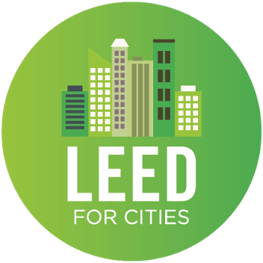It is clear that the executive branch is not shy about its stance on climate change and sustainability. With the United States rejoining the Paris Climate Accords in January of this year, and a renewed pressure to take appropriate action to divert greenhouse gas emissions, serious action is now being taken to protect the environment. Among these actions is an encouragement for cities nationwide to introduce environmentally responsible programs to ensure the health of, not only the surrounding ecosystems, but of its citizens as well. According to the United Nations, 68% of the global population could live in cities by 2050 (which means an additional 2.5 billion people will be living there). It has therefore become more crucial for cities to take sustainability seriously. One way for cities and communities to accomplish this is through LEED certification, the most widely used green rating system in the world.
LEED Rating for Cities and Communities

Aligned with the United Nations Sustainable Development Goals, LEED for Cities and Communities is a green-building certification program that assists localities in living more responsibly through the creation of detailed plans regarding natural systems, energy, water, waste, and transportation. According to LEED, cities consist of “places with a governing body,” and can also include "towns, counties and other local government jurisdictions,” while communities are any “non-city places, such as regions, districts, business improvement districts (BIDs), economic development zones, neighborhoods, campuses and military installations”.
LEED offers something for cities and communities of all shapes and sizes -- publicly or privately managed, new or old, and at different stages of development -- towards their sustainability goals. It allows localities to measure their progress against other cities and communities across the globe, and the program is flexible enough to be applied to both new and existing buildings.
Rating Factors
LEED for Cities and Communities uses a rating system of 7 broad categories for localities to base their plan of action around and allows cities and communities to focus on what is most important to them:
- Natural Systems and Ecology
- Transportation and Land Use
- Water Efficiency
- Energy and Greenhouse Gas Emissions
- Materials and Resources
- Quality of Life
Performance in these categories is tracked through an accumulation of credits and prerequisites. When applying for certification, there are 14 metrics across five categories of prerequisites that must be met for these cities and communities to be certified:
- Energy
- Water
- Waste
- Transportation
- Quality of Life
Who’s Doing It
As of March 2021, 160 cities worldwide have been LEED certified including Columbus and Cincinnati, Ohio, and even larger cities such as Las Vegas, Nevada, Washington, D.C. and Phoenix, Arizona in addition to many others.
Countries outside of the U.S. are making changes as well. For example, Denmark is highly focused on reducing their carbon emissions from transportation. By reorganizing their roadways in Copenhagen, they have been able to encourage more residents to travel by bicycle (62% in fact!) and now only 9% drive.
Another example comes to us from Italy. In Milan, in an effort to increase the number of green spaces, architects have created vertical forests--tower buildings covered in tree cover (including 800 trees, 4,500 shrubs and 15,000 plants). Similar projects are planned in China, Switzerland, and The Netherlands.
With a recent $500,000 grant from the Bank of America made in 2020, 20 new cities were selected to become LEED certified, with Cleveland, Ohio being among them. Bank of America has made previous grants to the LEED Cities and Communities program, providing support to a total of 41 localities. So if your city or community is interested in becoming certified and lacks the necessary funding, be on the lookout for future grants that can offer financial assistance.
Making Cities & Communities Responsible
If you are a manager representing a jurisdiction, planner developing a new city or community, local developer working on a district or collection of buildings on an urban site or a housing authority, or local group measuring the sustainability of a neighborhood, you may be eligible to submit an application for your city or community for LEED certification. You will first need to register in LEED Online, then optionally pre-certify your city or community, certify and then recertify your locality. Recertification is ongoing as data consistently comes in revealing gaps and vulnerabilities in a city or community's plan that require improvement, however action is typically required every three years to maintain LEED certification.
Join the multitude of cities and communities worldwide that are maintaining LEED Cities and Communities certification and communicating their commitment to sustainability. Emerald Built Environments can help you determine the best plan of action to ensure your city or community becomes LEED certified and remains environmentally responsible.
Posts by Tag
- Sustainability (171)
- sustainability consulting (143)
- Energy Efficiency (126)
- Utilities (91)
- LEED (87)
- Sustainable Design (69)
- green building certification (59)
- energy audit (46)
- ESG (45)
- construction (43)
- GHG Emissions (36)
- WELL (32)
- carbon neutrality (31)
- net zero (27)
- tax incentives (27)
- costs (26)
- energy modeling (18)
- electric vehicles (17)
- Energy Star (14)
- Housing (14)
- Inflation Reduction Act (13)
- water efficiency (13)
- Social Equity (12)
- decarbonization (12)
- diversity (10)
- NGBS (7)
- fitwel (7)
- Earth Day (6)
- electrification (5)
- mass timber (5)
- non-profit (5)
- retro-commissioning (5)
- Emerald Gives (4)
- Engineering (4)
- News Releases (4)
- B Corp (3)
- COVID-19 Certification (3)
- Customers (3)
- Indoor Air Quality (3)
- PACE (3)
- Arc (2)
- DEI (2)
- EcoDistricts (2)
- EcoVadis (2)
- Green Globes (2)
- cannabis (2)
- CDP (1)
- SITES (1)
- furniture (1)
- opportunity zone (1)
- womenleaders (1)


